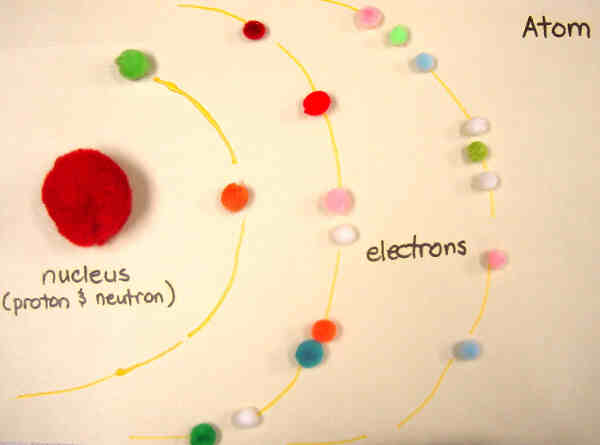BACKGROUND:
Light switches can be found anywhere
in the house: in kitchens, bedrooms, hallways, and even cellars. See if
your students know what a light switch does? If you flip a switch up, a
light comes on. When you flip the switch down, the light goes off. It
almost seems like magic, but it's not. It's electricity.
Electricity is when electrons move in one
direction. The movement of the electrons can be static or
current. Static electricity means that the electrons go off in
different directions. Current electricity is when the electrons go
through a conductor like copper wire.
Young children do not know about electrons.
It is important for them to realize that everything has electrons and a
nucleus with protons and neutrons inside. The electrons can easily
move away. The electrons run around the nucleus in a defined
pattern. The first loop has two electrons, the second has eight,
and so does the third loop.
In
this art activity children are learning the word nucleus and
electrons. It is so they can start to visualize the tiny atomic
world.
PROCEDURE:
- Switch on, Switch off
(Harper Collins) is an introduction to the topic of electricity and
shows how magnetism is related to electricity. It explains about
circuits, generators, light bulbs, and plugs. The book also shows
students how to make electricity with the use of a magnet. (This may be
difficult for kindergarten students and we recommend you skip this
portion of the book.)
- Illustrate how electricity works
by telling students that all substances are made up of electrons,
protons, and neutrons. Electricity is when electrons all move together
in the same direction. You can do the following with your class to
illustrate this point. Go outside with students and tell them that
electrons are all around. Have students each stand in one place and act
like an electron minding its own business. Don't let them interact with
each other. When you say "Switch On", have the students walk
in the same direction, like in a parade. The flow of electrons will now
cause electricity. "Switch Off", and the students should go
 back to being solitary electrons. Repeat the exercise until students get
the idea that electrons moving in the same direction create electricity.
back to being solitary electrons. Repeat the exercise until students get
the idea that electrons moving in the same direction create electricity.
- Remember that neither you nor your
students have to understand electrons to introduce the term.
Use a large piece of paper (11"x17") and have the
students create their own atom. An atom consists of a
nucleus (with protons and neutrons inside) and electrons revolving
(and also rotating on their own axis) around the nucleus. Students
should count out 1 large pom pom and 18 small ones. Glue the
pom poms as suggested in the picture and then paint (puff paint
works well) the line of movement of each loop.